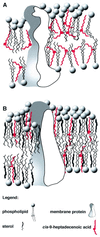Specificity and mode of action of the antifungal fatty acid cis-9-heptadecenoic acid produced by Pseudozyma flocculosa
- PMID: 11157268
- PMCID: PMC92672
- DOI: 10.1128/AEM.67.2.956-960.2001
Specificity and mode of action of the antifungal fatty acid cis-9-heptadecenoic acid produced by Pseudozyma flocculosa
Abstract
cis-9-Heptadecenoic acid (CHDA), an antifungal fatty acid produced by the biocontrol agent Pseudozyma flocculosa, was studied for its effects on growth and/or spore germination in fungi. Inhibition of growth and/or germination varied considerably and revealed CHDA sensitivity groups within tested fungi. Analysis of lipid composition in these fungi demonstrated that sensitivity was related primarily to a low intrinsic sterol content and that a high level of unsaturation of phospholipid fatty acids was not as involved as hypothesized previously. Our data indicate that CHDA does not act directly with membrane sterols, nor is it utilized or otherwise modified in fungi. A structural mechanism of CHDA, consistent with the other related antifungal fatty acids produced by P. flocculosa, is proposed in light of its activity and specificity. The probable molecular events implicated in the sensitivity of fungi to CHDA are (i) partitioning of CHDA into fungal membranes; (ii) a variable elevation in fluidity dependent on the buffering capability (sterol content) in fungi; and (iii) higher membrane disorder causing conformational changes in membrane proteins, increased membrane permeability and, eventually, cytoplasmic disintegration.
Figures

References
-
- Avis T J, Bélanger R R. Synthesis and biological characterization of (Z)-9-heptadecenoic and (Z)-6-methyl-9-heptadecenoic acids, fatty acids with antibiotic activity produced by Pseudozyma flocculosa. J Chem Ecol. 2000;26:987–1000.
-
- Bélanger R R, Deacon J W. Interaction specificity of the biocontrol agent Sporothrix flocculosa: a video microscopy study. Phytopathology. 1996;86:1317–1323.
-
- Bélanger R R, Labbé C, Jarvis W R. Commercial-scale control of rose powdery mildew with a fungal antagonist. Plant Dis. 1994;78:420–424.
-
- Benyagoub M, Bel Rhlid R, Bélanger R R. Purification and characterization of new fatty acids with antibiotic activity produced by Sporothrix flocculosa. J Chem Ecol. 1996;22:405–413. - PubMed
-
- Benyagoub M, Willemot C, Bélanger R R. Influence of a subinhibitory dose of antifungal fatty acids from Sporothrix flocculosa on cellular lipid composition in fungi. Lipids. 1996;31:1077–1082. - PubMed
Publication types
MeSH terms
Substances
LinkOut - more resources
Full Text Sources
Other Literature Sources
Medical

